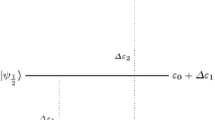Abstract
Unlike the standard Quantum Computational Logic (QCL), where the carrier of information (target) is conventionally assumed to be only the last qubit over a sequence of many qubits, here we propose an extended version of the QCL (we call Multi Target Quantum Computational Logic) where the number and the position of the target qubits are arbitrary.


Similar content being viewed by others
Notes
It is easy to see that \(Swap_{[k;m,m+n-1]}^{-1}=Swap_{[k;m,m+n-1]}\) for any value of k, m and n.
Let us give a slight abuse of the terms target and control remarking that, for example, if we refer to the picture of the Sect. 3, the qubit \(\vert {x_1} \rangle\) is not a control qubit but, accordingly with this notation, it assumes a control position over the quantum circuit where it is located.
Notice that the probability \({\texttt {p}}\) we refer to is the one introduced in the context of the standard QCL (see Eq. 4.1). On this basis, we are using this example to express the MT-QCL probability \({\texttt {P}}\) in terms of the QCL probability \({\texttt {p}}\).
References
Beltrametti, E., Dalla Chiara, M. L., Giuntini, R., Leporini, R., & Sergioli, G. (2012). Epistemic quantum computational structures in a Hilbert-space environment. Fundamenta Informaticae, 115, 1–14.
Dalla Chiara, M. L., Giuntini, R., & Greechie, R. (2004). Reasoning in quantum theory: Sharp and unsharp quantum logic. Trends in logic. Berlin: Springer.
Dalla Chiara, M. L., Giuntini, R., Leporini, R., Negri, E., & Sergioli, G. (2015). Quantum information, cognition and music. Frontiers in Psychology, 6, 1583.
Dalla Chiara, M. L., Giuntini, R., Leporini, R., & Sergioli, G. (2016). Holistic logical arguments in quantum computation. Mathematica Slovaca, 66(2), 313–334.
Dalla Chiara, M. L., Giuntini, R., & Sergioli, G. (2013). Probability in quantum computationa and in quantum computational logic. Mathematical structures in computer science (Vol. 14). Cambridge: Cambridge University Press.
Devitt, S. J. (2016). Performing quantum computing experiments in the cloud. Physical Review A. https://doi.org/10.1103/PhysRevA.94.032329.
Fowler, A. G., Hill, C. D., & Hollenberg, L. C. L. (2004). Quantum error correction on linear nearest neighbor qubit arrays. Physical Review A, 69, 042314.1–042314.4.
Fuchs, J. (1992). Affine Lie algebras and quantum groups. Cambridge: Cambridge University Press.
Gerdt, V. P., Kragler, R., & Prokopenya, A. N. (2009). A Mathematica program for constructing quantum circuits and computing their unitary matrices. Physics of Particles and Nuclei Letters, 6, 526.
Gerdt, V. P., & Prokopenya, A. N. (2011). The circuit model of quantum computation and its simulation with Mathematica. In Mathematical modelling and computer science, LNCS (pp. 43–55). Springer.
Häffner, H., Hänsel, W., Roos, C. F., Benhelm, J., Chek al kar, D., Chwalla, M., et al. (2005). Scalable multipartite entanglement of trapped ions. Nature, 438, 643–646.
Hirvensalo, M. (2001). Quantum computing. Natural computing series. Berlin: Springer.
Holik, F, Sergioli, G., Freytes, H., & Plastino, A. (2018). Pattern recognition in non-Kolmogorovian structures. Foundations of Science, 23(1), 119–132.
Jozsa, R., & Miyake, A. (2008). Matchgates and classical simulation of quantum circuits. Proceedings of the Royal Society A, 464, 3089–3106.
Kane, B. (1998). A silicon-based nuclear spin quantum computer. Nature, 393, 133–137.
Kitaev, A. Y., Shen, A., & Vyalyi, M. N. (2002). Classical and quantum computation. Graduate studies in mathematics (Vol. 47). Rhode Island: AMS.
Kumar, P. (2013). Efficient quantum computing between remote qubits in linear nearest neighbor architectures. Quantum Information Processing, 12–4, 1737–1757.
Laforest, M., Simon, D., Boileau, J. C., Baugh, J., Ditty, M., & Laflamme, R. (2007). Using error correction to determine the noise model. Physical Review A, 75, 133–137.
Ledda, A., & Sergioli, G. (2010). Towards quantum computational logics. International Journal of Theoretical Physics, 49, 3158–3165.
Linke, N. M., Maslov, D., Roetteler, M., Debnath, S., Figgatt, C., Landsman, K. A., et al. (2017). Experimental comparison of two quantum computing architectures. Proceedings of the National Academy of Sciences of the United States of America, 114, 3305–3310.
Nielsen, M. A., & Chuang, I. (2000). Quantum computation and quantum information. Cambridge: Cambridge University Press.
Sergioli, G. (2017). Quantum circuit optimization for unitary operators over non-adjacent qudits. arXiv:1711.09765 [quant-ph]
Sergioli, G., & Freytes, H. (2017). Fuzzy approach to quantum Fredkin gate. Journal of Logic & Computation, 28(1), 245–263.
Sergioli, G., Giuntini, R., & Paoli, F. (2011). Irreversibility in quantum computational logics. Applied Mathematics and Information Sciences, 5(2), 171–191.
Sergioli, G., Santucci, E., Didaci, L., Miszczak, J. A., & Giuntini, R. (2017). A quantum inspired version of the NMC classifier. Soft Computing, 22(3), 691–705.
Takahashi, Y., Kunihiro, N., & Ohta, K. (2007). The quantum Fourier transform on a linear nearest neighbor architecture. Quantum Information and Computation, 7, 383–391.
Toffoli, T. (1980). Reversible computing. In Proceedings of the 7th colloquium on automata, languages and programming (pp. 632–644). London: Springer.
Acknowledgements
This work is partially supported by Regione Autonoma della Sardegna within the project “Time-logical evolution of correlated microscopic systems” CRP 55, L.R. 7/2007 (2015) and by Fondazione Sardegna within the project “Strategies and Technologies for Scientific Education and Dissemination” (2017).
Author information
Authors and Affiliations
Corresponding author
Rights and permissions
About this article
Cite this article
Sergioli, G. Towards a Multi Target Quantum Computational Logic. Found Sci 25, 87–104 (2020). https://doi.org/10.1007/s10699-018-9569-8
Published:
Issue Date:
DOI: https://doi.org/10.1007/s10699-018-9569-8




